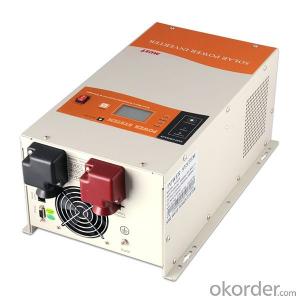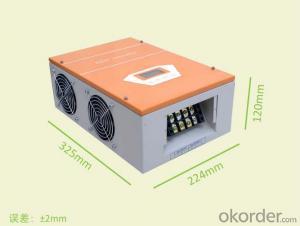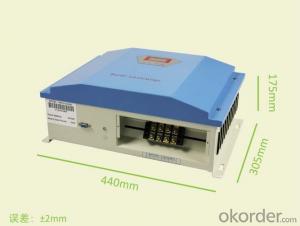2KVA/3KVA Inverter MPPT solar charge controller
- Loading Port:
- Shekou
- Payment Terms:
- TT OR LC
- Min Order Qty:
- 100 pc
- Supply Capability:
- 30000 pc/month
OKorder Service Pledge
OKorder Financial Service
You Might Also Like
Main Features
Pure sine wave inverter
Built-in MPPT solar charge controller
Selectable input voltage range for home appliances and personal computers
Selectable charging current based on applications
Configurable AC/Solar input priority via LCD setting
Compatible to mains voltage or generator power
Auto restart while AC is recovering
Overload and short circuit protection
Smart battery charger design for optimized battery performance
Cold start function
Rated Power 2000VA/1600W 2000VA/1600W 3000VA/2400W 3000VA/2400W
INPUT
Voltage 120 VAC or 230 VAC
Selectable Voltage Range 95-140 VAC or 170-280 VAC (For Personal Computers)
65-140 VAC or 90-280 VAC (For Home Appliances)
Frequency Range 50 Hz/60 Hz (Auto sensing)
OUTPUT
AC Voltage Regulation (Batt. Mode) 110/120 VAC ± 5% (User selectable) or 230VAC ± 5%
Surge Power 4000VA 6000VA
Efficiency (Peak) 90% - 93%
Transfer Time 10 ms (For Personal Computers)
20 ms (For Home Appliances)
Waveform Pure sine wave
BATTERY & AC CHARGER
Battery Voltage 24 VDC 48 VDC 24 VDC 48 VDC
Floating Charge Voltage 27 VDC 54 VDC 27 VDC 54 VDC
Overcharge Protection 31 VDC 62 VDC 31 VDC 62 VDC
Maximum Charge Current 20 A or 20 A / 30 A* 10 A or 10 A / 15 A* 20 A or 20 A / 30 A* 10 A or 10 A / 15 A*
SOLAR CHARGER
Maximum PV Array Power 1500 W 3000 W 1500 W 3000 W
MPPT Range @ Operating Voltage 30~ 115 VDC or 60 ~ 115 VDC 60 ~ 115 VDC 30~ 115 VDC or 60 ~ 115 VDC 60 ~ 115 VDC
Maximum PV Array Open Circuit
Voltage 145 VDC
Maximum Charging Current 60A
Maximum Efficiency 98%
Standby Power Consumption 2 W
PHYSICAL
Dimension, D x W x H (mm) 140 x 295 x 479
Net Weight (kgs) 11.5
OPERATING ENVIRONMENT
Humidity 5% to 95% Relative Humidity(Non-condensing)
Operating Temperature 0°C - 55°C
Storage Temperature -15°C - 60°C
- Q: Can a solar inverter be used with both AC and DC power sources?
- No, a solar inverter is designed to convert DC power from solar panels into AC power for use in standard electrical systems. It cannot be used with both AC and DC power sources simultaneously.
- Q: Can a solar inverter be used in standalone systems?
- Yes, a solar inverter can be used in standalone systems. Standalone systems, also known as off-grid systems, are not connected to the electrical grid and rely on alternative sources of power such as solar panels. Solar inverters are crucial in standalone systems as they convert the direct current (DC) produced by the solar panels into alternating current (AC) that is used to power household or commercial appliances.
- Q: What is the role of power ramp rate control in a solar inverter?
- The role of power ramp rate control in a solar inverter is to ensure a smooth and controlled increase or decrease in power output from the solar panels. This control mechanism is important to prevent sudden changes in power generation that can lead to instability in the electrical grid. By gradually adjusting the power output, the solar inverter helps to maintain grid stability, avoid voltage and frequency fluctuations, and ensure a reliable and consistent energy supply.
- Q: How does a solar inverter handle voltage sag or drop in the grid?
- A solar inverter handles voltage sag or drop in the grid by constantly monitoring the grid voltage. When it detects a drop in voltage, it adapts its operation to ensure that the output voltage from the solar panels matches the grid voltage, thereby stabilizing and compensating for the voltage sag or drop. This helps to maintain a consistent and reliable power supply from the solar panels to the grid.
- Q: How do you calculate the maximum power point tracking range for a solar inverter?
- To calculate the maximum power point tracking (MPPT) range for a solar inverter, you need to consider the solar panel's voltage and current characteristics. The MPPT range is determined by finding the maximum power output from the solar panel, which occurs at the point where the voltage and current are optimized. This is typically done by using a control algorithm that adjusts the inverter's operating point to track the maximum power point. The range will depend on various factors such as the solar panel's temperature, irradiance, and electrical characteristics.
- Q: Can a solar inverter be used in parallel configurations for increased power output?
- Yes, a solar inverter can be used in parallel configurations to increase power output. By connecting multiple inverters in parallel, the total power output can be increased, allowing for more efficient utilization of solar energy.
- Q: Can a solar inverter be used with different types of power conditioning units?
- Yes, a solar inverter can be used with different types of power conditioning units as long as they are compatible and properly integrated into the solar power system. The inverter's specifications and features should be considered to ensure compatibility with the specific power conditioning unit being used.
- Q: Can a solar inverter be connected to a computer or smartphone?
- Yes, a solar inverter can be connected to a computer or smartphone. Many modern solar inverters are equipped with built-in Wi-Fi or Bluetooth capabilities, allowing them to connect to local networks. This enables users to monitor and control their solar system's performance and settings conveniently through dedicated software applications or web interfaces on their computers or smartphones.
- Q: Can a solar inverter be used in a solar-powered data center?
- Yes, a solar inverter can be used in a solar-powered data center. A solar inverter is an essential component of a solar power system as it converts the direct current (DC) generated by solar panels into alternating current (AC) that can be used to power electrical devices in a data center. By using a solar inverter, a solar-powered data center can efficiently utilize the electricity generated from solar panels to meet its power requirements.
- Q: How does a solar inverter handle voltage fluctuations?
- A solar inverter handles voltage fluctuations by continuously monitoring the input voltage from the solar panels. When there is a fluctuation in the input voltage, the inverter adjusts its internal circuitry to ensure a stable and consistent output voltage. This helps protect the connected appliances and grid from potential damage caused by sudden voltage changes.
Send your message to us
2KVA/3KVA Inverter MPPT solar charge controller
- Loading Port:
- Shekou
- Payment Terms:
- TT OR LC
- Min Order Qty:
- 100 pc
- Supply Capability:
- 30000 pc/month
OKorder Service Pledge
OKorder Financial Service
Similar products
Hot products
Hot Searches
Related keywords























